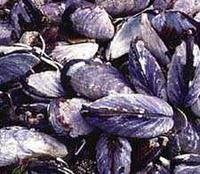Mussel
MUSSEL is a marine MOLLUSC belonging to the class Bivalvia. Its soft body is enclosed in a hinged shell with 2 halves (valves). Several species occur in BC waters. The most common species live in dense colonies attached to rocks, pilings or other hard surfaces; others live in the substrate. The shell is anchored by a bundle of fine threads known as the byssus, made from the mucus of a special gland. Most familiar is the Pacific blue (bay) mussel (Mytilus trossulus), which has a dark blue to black shell and grows to 11 cm. The blue mussel is common in protected waters in the intertidal zone, along the beach or clinging to wharfs and piers. Found worldwide, blue mussels once were thought to be one species but are now considered to be several species or subspecies. The thicker-shelled California mussel (M. californianus) is the largest mussel species found in BC. It grows to 25 cm and is generally found in extensive beds on surf-exposed rocks, wharfs and seamounts, often in association with the goose BARNACLE.
FIRST NATIONS people ate mussels and used the sharp-edged shells for tools and weapons. Attempts to culture the Pacific blue mussel in BC have been thwarted by heavy predation by the diving DUCK, by market competition from growers on the east coast and in New Zealand, and by a phenomenon known as summer mortality, which claims up to 90% of a crop just as it approaches market size. Biologists speculate that warm summer water temperatures may be the cause of summer mortality. Like other filter feeders, mussels can become toxic to humans through HARMFUL ALGAL BLOOMS. They are used as an indicator species in coastal testing because they accumulate toxins more quickly than other bivalves.
by Carol Swann

